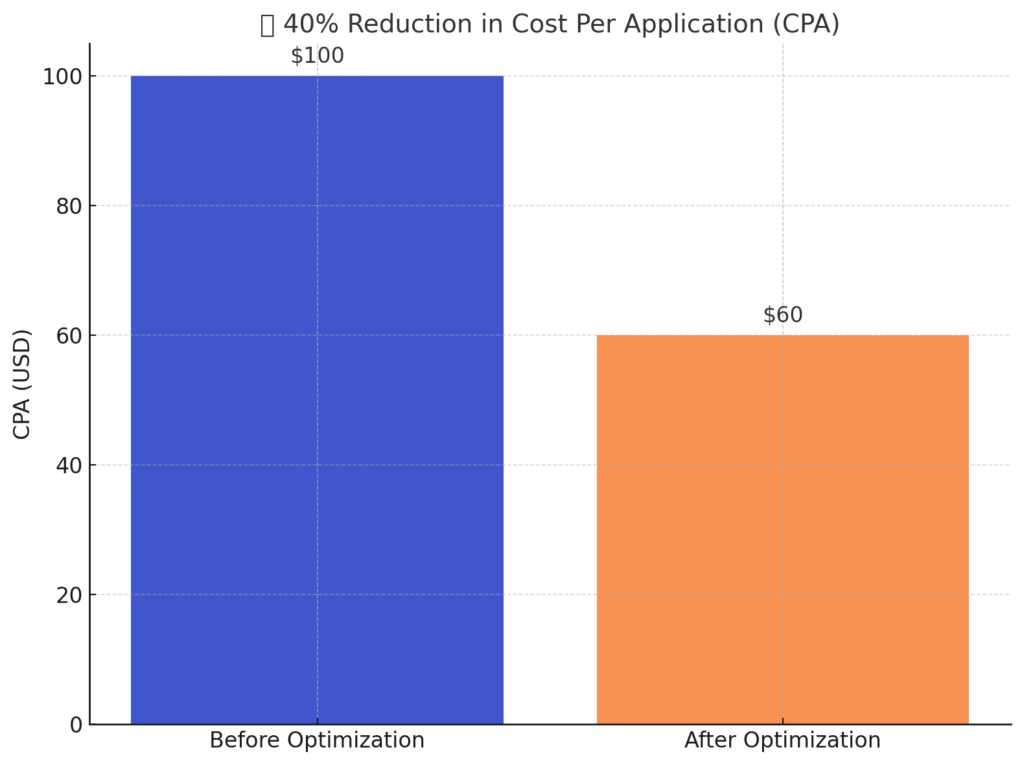The Client 🏫
The client is a well-known university in the United States, recognized for academic excellence and its diverse range of undergraduate and graduate programs. As part of a broader institutional goal to increase application submissions and improve marketing ROI, the university had been actively investing in multiple digital advertising channels.
At the time we were engaged, the institution was operating with limited insight into performance metrics. Although ad budgets were being allocated across platforms such as Google Ads, Meta Ads, and LinkedIn, there was no centralized reporting system, and key conversions like application submissions were not being consistently tracked.
The Challenge 🤔
The university faced several core challenges:
- Inconsistent tracking of critical conversions, including application starts and completions.
- Siloed reporting across marketing platforms, making it difficult to assess campaign effectiveness or compare channel performance.
- Lack of a unified analytics dashboard, leaving teams unable to view results in real time or optimize spend based on accurate insights.
- Limited ability to identify and respond to website performance issues impacting the user journey.
Ultimately, the institution sought a comprehensive data strategy that would allow them to track performance across all digital touchpoints, understand which channels drove the most value, and inform ongoing marketing decisions with accurate, real-time data.
ScaledOn’s Strategy 🧠
To meet these challenges, we implemented a multi-phase solution focused on tracking accuracy, integrated reporting, and continuous optimization.
1. Technical Infrastructure for Tracking
- Deployed an advanced Google Tag Manager (GTM) setup across the university’s web properties.
- Configured tracking for key actions, including:
- Application starts and submissions
- Contact form completions
- Downloadable brochure clicks
- Engagement events like scroll depth and outbound link clicks
- Application starts and submissions
- Ensured proper installation of tracking pixels for Google Ads, Meta, and LinkedIn to enable accurate cross-platform attribution.
2. Unified Reporting via Custom Dashboard
- Built a centralized Google Data Studio (Looker Studio) dashboard integrating:
- Google Analytics
- Google Ads
- Meta Ads
- LinkedIn Ads
- Internal CRM and form data (where available)
- Google Analytics
- Delivered real-time insights on:
- Cost-per-application (CPA)
- Conversion rates per channel
- Visitor behavior and drop-off rates
- Budget efficiency and top-performing campaigns
- Cost-per-application (CPA)
3. Ongoing Analysis and Strategic Support
- Conducted monthly reviews to:
- Evaluate campaign and channel performance
- Identify bottlenecks in the application funnel
- Uncover site-level UX issues
- Recommend optimizations based on data trends
- Evaluate campaign and channel performance
What went well 🌟
✅ Successes
- Tracking implementation was completed on schedule, enabling real-time insights within weeks.
- The institution’s marketing and enrollment teams quickly adopted the dashboard as a centralized decision-making tool.
The insights uncovered allowed for data-backed reallocation of budget, driving more efficient use of paid media spend.
What We Learned 💡
⚠️ Challenges and Midstream Adjustments
- Cross-domain tracking was initially impacted by limitations in the university’s internal tech stack, requiring custom tagging solutions.
- A mid-year website redesign introduced new variables that required revalidation of tracking and updates to our data integrations.
In response, we built a tracking QA process that proactively flagged issues as new pages or campaigns were launched.
The Key Results 🙌
Since implementation, the institution has realized significant improvements in both campaign efficiency and application performance:
- 📈 Increase in Attributed Application Submissions
Accurate tracking enabled the university to measure and optimize for real conversions properly. - 💰40% Reduction in Cost Per Application (CPA)
Data-informed budget shifts focused spend on top-performing channels. - 📊 Real-Time Performance Insights
Stakeholders gained 24/7 access to unified reporting, reducing decision-making time and increasing agility. - 🔍 Identification and Resolution of Over 12 Site-Level Issues
Data flow analysis helped pinpoint high drop-off areas in the application process.


